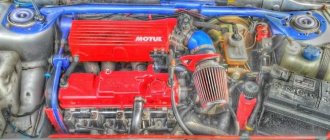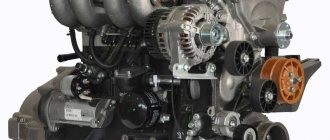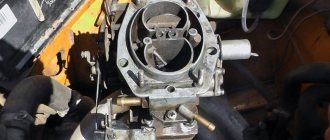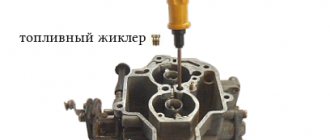Tuning VAZ 2103
VAZ 2103 belongs to those cars with which the domestic automobile industry began. Just like the other two models - VAZ 2101 and VAZ 2102, the “troika” was developed on the basis of the Fiat 124. The Volzhsky plant workers put a lot of effort into creating a comfortable and dynamic car for that time. The model, whose production began in 1972, despite its advanced age, can often be seen on the roads today. Many owners resort to making changes to the vehicle to improve certain characteristics, appearance or interior.
What is tuning
Car tuning is changing factory parameters in order to improve them. There is something to improve on the VAZ 2103: units, appearance, interior, etc. It is worth understanding that more serious tuning, as a rule, concerns the technical part of the car, specifically the engine, exhaust system, gearbox, ignition system. A simpler option is also possible - tinting the windows and installing modern optics. However, all these issues are worth understanding in more detail.
Photo of a tuned VAZ 2103
Today you can find many tuned cars, including the third model Zhiguli. Therefore, it is quite logical to consider examples of modified cars.
Photo gallery: tuning VAZ 2103
Even minor changes to a standard car can make it more attractive
Body tuning opens up wide opportunities for making changes to the standard appearance of the car
Tuning allows you to give your car an individual style and character.
Two attempts to make three: tuning VAZ-2103
Classics for drifting, classics for rallying - that's all, you say, we've already seen it. Yes, we note that we didn’t treat you like this, but we haven’t served “troika” in this sauce yet.
In reality, creating even such a “standard” project turned out to be more difficult than composing a simple poem like the one above. The mistakes, however, also turned out to be “typical”, but that’s what tuning is famous for: everyone who works on their project themselves often walks on a rake that just fell after the previous enthusiast.
Concept
The beginning of the project dates back to November 2014, when the VAZ-2103 found a new owner in the person of Oleg. There were quite “classic” plans for the “classic” car: buy it in order to inexpensively understand what drifting is and whether it’s worth pursuing it further. Immediately after the purchase, it was slightly modified for targeted trips: steering bipods shortened by 30 mm were installed to increase the wheel turnout and the differential was welded, and a basic set of a “bucket” and a sports steering wheel appeared in the cabin. And - let's go.
From December to March, the “troika” was mercilessly exploited in the field of studying the basics of controlled skidding on all possible routes near Moscow, and by the end of winter it turned into a hill of crumpled metal. But Oleg understood that winter skiing is not only interesting, but also quite affordable. Therefore, having assessed the condition of the load-bearing body elements of his Lada, such as the floor and side members, he was convinced that they were “still usable”, and decided not to scrap the car, but to restore it to continue amateur competitions.
Tuning the body of the VAZ 2103
The first thought that comes to the mind of car owners who decide to tune their “troika” is to update the paint. However, in this case, you should use shades different from standard colors, since ordinary paint is not attractive in any way. One of the modern styling methods is liquid rubber. With the help of this material, it becomes possible to make the car not only attractive, but also to create a protective layer from negative external influences. Regardless of the chosen method of tuning the body, the surface must first be prepared: remove rust and eliminate any existing defects.
Windshield tinting
A fairly simple and common way of tuning a VAZ 2103, like any other car, is to tint the windows with film. This improvement allows you to change not only the appearance of the car, but also increase the level of safety. If the car gets into an accident, the tinted glass will not shatter into small fragments. In addition, in summer, tinting protects against bright sunlight.
Before choosing a tinting material, you need to take into account that, in accordance with current legislation, the windshield must transmit at least 70% of the light. In addition, the surface itself has optical resistance, i.e. glass transmits no more than 90% of light. As the car is used, cracks and chips appear on the glass, which negatively affects light transmission. To tint your windshield and not worry about problems with traffic police officers, you need to choose a film with a light transmittance of 80%.
The most widespread method is the film method of tinting car windows. The advantages of this option are that the film can be applied in a garage without much difficulty, and if necessary, it can be easily removed from the surface. For tinting you will need the following list of materials and tools:
- yardstick;
- corner forcing for hard-to-reach places;
- rubber waterproofing;
- sharp blade for removing glue;
- mild steel knife;
- technical hair dryer;
- sprinkler or water spray.
Having prepared everything you need, including the material for darkening the glass, you can begin the process. The film is applied using a soap solution, thanks to which you can adjust the position of the product and remove air bubbles. To prevent fingerprints from remaining on the film and glass, it is recommended to wear rubber gloves (medical).
The windshield can be tinted completely or partially
Before applying tinting, the glass is cleaned of dirt both outside and inside, and then washed. Then measurements are taken and the film is cut out in accordance with the required parameters. Water is sprayed from a spray bottle onto the outside of the windshield and a darkening material is applied, placing the film with the protective layer facing up. After that, it is leveled and the desired shape is cut out with a sharp blade.
After these steps, separate the protective layer from the tint material and spray the solution onto it. Then they remove the film from the glass, bring it inside the car and stick it on the windshield. The main rule in the tinting process is to smooth the tinting well so that there are no folds or bubbles left on it. A hairdryer and forcing will help with this.
Tinting and grille on the rear window of VAZ 2103
It is worth taking into account the fact that the rear window is the most difficult to tint due to its curves. Therefore, it is recommended to apply the film in three longitudinal strips, which are cut out and applied according to a template. You can use wallpaper for this. After measuring and cutting the required length from the roll, the paper is applied to the glass and cut along the contour. To keep the paper on the surface, it can be slightly moistened. Make 2 more stripes in the same way. Then the film is cut according to the finished template and applied similarly to the windshield. Some motorists recommend removing the glass for tinting, but not everyone follows this. Darkening the side windows should not cause any difficulties: the surface is flat, and the process itself is the same as with the front and rear windows.
Sometimes you can find a VAZ 2103 with a grille on the rear window. Some may find this tuning option outdated, while others, on the contrary, are of the opinion that a car with such an accessory becomes more sporty and aggressive. The grille is attached to the rear window seal. To do this, you will need to dismantle the glass, insert the lock into the rubber band and place the grille under the sealing element. Then, using a rope, install the glass on the car.
The grille on the rear window allows you to give the car a more aggressive appearance.
Before deciding to purchase and install the product in question, you need to consider the pros and cons of this accessory. The positive qualities of the lattice include the following:
- the interior heats up less in hot weather;
- the glass does not fog up so much when it rains;
- Vehicles moving behind are less likely to dazzle at night.
The negative aspects include:
- difficulties in removing snow stuck to the glass;
- problems with removing debris that gets stuck in the corners under the grate.
Video: tinting the rear window on a “classic”
Roll cage
A car safety cage is a structure that prevents severe damage to the vehicle body in the event of a collision or rollover and saves the life of the driver and passengers. The product is a spatial structure that has a rigid connection (welding, bolted connections) with body elements.
Is a safety cage needed on a VAZ 2103? If you don't race, then probably not. The fact is that it will not be so easy to pass technical inspection with such a product: this will require an appropriate certificate. Plus, a car equipped with a safety cage is prohibited from being used in the city. Despite the fact that the structure is installed for protection purposes, the product, upon impact, can, on the contrary, aggravate the situation, for example, collapse due to improper installation. In addition, the cost of the frame is not cheap. The price depends on the complexity of the product and can reach 10 thousand dollars.
A roll cage increases body rigidity, but is only installed on competition cars
Retro tuning
It is more common for motorists to tune relatively new cars. The main goals pursued in this case are to give individuality so that the car does not look like serial copies. As a result, the vehicle's level of quality, comfort and safety increases. However, there is a slightly different direction in car tuning, called retro tuning.
During restoration work, they try to return a car that has been out of production for a long time to its original appearance. If we consider the VAZ 2103, which was discontinued back in 1984, then in those days the car was familiar to everyone and did not stand out in any way. However, today such a car can look quite interesting and be perceived as exclusive, attracting people’s attention.
To perform retro tuning, you need to restore the car. The work is aimed at restoring the body and bringing it to almost perfect condition. A lot of effort is put into restoring the interior: they sew the interior, make, if it is impossible to restore, decorative elements. If you delve deeper into the process, this is quite painstaking and financially expensive work.
However, a complete restoration of a car is not always necessary, because everything depends on the goals being pursued. There are situations when the appearance of the car is left unchanged, but technically the car is completely re-equipped, replacing the suspension, engine, gearbox, etc., which allows you to move quite confidently in modern traffic.
Retro tuning involves restoring the car to its original appearance.
Technical characteristics of VAZ engines
The technical characteristics of VAZ Classic engines are quite simple. During the production of the first engine, the engines were improved and the VAZ 2106 and 2107 engines are considered to be the best representatives.
Before we begin describing maintenance and repair, it is worth understanding which VAZ engines were installed on the “Classic”:
Lada 2101 "Kopeyka"
We can say that this is the most legendary car produced by AvtoVAZ. To this day, this vehicle and power unit can be found throughout the CIS and beyond.
VAZ 2101
| Name | Characteristic |
| Brand | 2101 |
| Marking | 1.2 l (1198 cm3) |
| Power | 64 hp |
| Type | Carburetor |
| Fuel | Petrol |
| Valve mechanism | 8 valve |
| Number of cylinders | 4 |
| Fuel consumption | 9.2 liters |
| Piston diameter | 76 mm |
| Resource | 120 - 150 thousand km |
VAZ 21011
| Name | Characteristic |
| Brand | 2101 |
| Marking | 1.3 l (1294 cm3) |
| Power | 69 hp |
| Type | Carburetor |
| Fuel | Petrol |
| Valve mechanism | 8 valve |
| Number of cylinders | 4 |
| Fuel consumption | 9.5 liters |
| Piston diameter | 79 mm |
| Resource | 120 - 150 thousand km |
All power units were equipped with a 4-speed gearbox. Also, the VAZ 2101 engine was installed on the Lada 2102. The successor to the power unit was the engine marked 2103.
VAZ 2103
Vehicles marked LADA 2103 were equipped with engines 2101, 21011 and the new VAZ 2103 engine.
| Name | Characteristic |
| Brand | 2103 |
| Marking | 1.5 l (1452 cm cube) |
| Power | 71 hp |
| Type | Carburetor |
| Fuel | Petrol |
| Valve mechanism | 8 valve |
| Number of cylinders | 4 |
| Fuel consumption | 8.5 liters |
| Piston diameter | 76 mm |
| VAZ engine life | 120 - 150 thousand km |
Like previous power units, the 2103 had a 4-speed gearbox. Cooling was liquid, forced, with a constantly running cooling fan.
VAZ 2104
The “Four” was produced for quite a long time, so its board received all possible engines and their modifications. Thus, VAZ engines of the following markings were mounted on the 2104: 2103, 2105, 21067, 21073 and 341. Let’s look at the characteristics in more detail:
Motor VAZ 2105
| Name | Characteristic |
| Brand | 2105 |
| Marking | 1.3 l (1290 cm3) |
| Power | 46 kW |
| Type | Carburetor |
| Fuel | Petrol |
| Valve mechanism | 8 valve |
| Number of cylinders | 4 |
| Fuel consumption | 10 liters |
| Piston diameter | 76 mm |
| VAZ engine life | 120 - 150 thousand km |
VAZ 21067
| Name | Characteristic |
| Brand | 21067 |
| Marking | 1.6 l (1569 cm3) |
| Power | 82 hp |
| Type | Injector |
| Fuel | Petrol |
| Valve mechanism | 8 valve |
| Number of cylinders | 4 |
| Fuel consumption | 8.2 liters |
| Econorm | Euro 2 |
| VAZ engine life | 150 - 180 thousand km |
VAZ 21073
| Name | Characteristic |
| Brand | 21073 |
| Marking | 1.7 l (1689 cm3) |
| Power | 84 hp |
| Type | Injector |
| Fuel | Petrol |
| Valve mechanism | 8 valve |
| Number of cylinders | 4 |
| Fuel consumption | 9.5 liters |
| Econorm | Euro 2 |
| VAZ engine life | 180 - 200 thousand km |
VAZ 341
Diesel version for a limited number of vehicles.
| Name | Characteristic |
| Brand | 341 |
| Marking | 1.5 l (1524 cm cube) |
| Power | 50 hp |
| Type | Diesel |
| Fuel | Diesel fuel |
| Valve mechanism | 8 valve |
| Number of cylinders | 4 |
| Fuel consumption | 6.7 liters |
| VAZ engine life | 220 - 250 thousand km |
VAZ 2105
Various power units were installed on the VAZ 2105 during production. Let's look at what VAZ engines the car labeled 2105 had:
- VAZ-2101 - 1.2 l, carburetor, 64 l. With.
- VAZ-2105 - 1.3 l, carburetor, 69 l. With.
- VAZ-2103 - 1.45 l, carburetor, 77 l. With.
- VAZ-2104 - 1.5 l, center. injection, 72 l. With.
- VAZ-21067 - 1.6 l, distribution. injection, 80 l. With.
- VAZ(BTM)-341 - 1.52 l, diesel, 50 l. With.
- VAZ-4132 - RPD, 1.654 l, 140 l. With.
VAZ 2106
The “Six”, in addition to the already familiar engines 2101 and 21011, received an improved power unit labeled 2106. This engine is considered one of the best VAZ carburetor internal combustion engines developed by the manufacturer. Let's look at the technical characteristics of the VAZ 2106:
| Name | Characteristic |
| Brand | 2106 |
| Marking | 1.6 l (1569 cm3) |
| Power | 75 hp |
| Type | Carburetor |
| Fuel | Petrol |
| Valve mechanism | 8 valve |
| Number of cylinders | 4 |
| Fuel consumption | 10.5 liters |
| Piston diameter | 79 mm |
| VAZ engine life | 150 - 180 thousand km |
VAZ 2107
This vehicle was produced at the AvtoVAZ plant for the longest time, for 30 years, after which it was discontinued because it was morally and technically outdated. If this car had been produced to this day, there would have been a very high demand for it, since the low price and simplicity of the design won the trust of motorists.
Both carburetor and injection engines were installed on the VAZ 2107 car. The first ones were marked 2103, 2105 and 2106. As for the injector, the VAZ engine was marked 21071 and 21073.
VAZ 2103 suspension tuning
Almost everyone who decides to improve not only the appearance of their “troika”, but also its handling, modifies the suspension. In addition, today we offer a wide selection of appropriate elements, the installation of which does not cause any particular difficulties. The suspension is modified based on the goals pursued. You can, for example, increase or, conversely, decrease the clearance. As a result of reducing ground clearance, the appearance of the car changes and the behavior of the car on the road improves. If the ground clearance needs to be increased, one of the available options is to install suspension parts from the VAZ 2104 model. Installing such springs also involves replacing shock absorbers.
On the VAZ 2103 and other “classics”, the eternal problem is the ball joints, the service life of which is not satisfactory, so they are replaced with reinforced ones, for example, from Track Sport. In addition, the “three-piece” suspension is distinguished by its softness. To add rigidity, a double anti-roll bar should be installed at the front, which will significantly improve the car's handling at speed. The stabilizer is also installed at the rear. Work on the chassis must be carried out carefully so that the vehicle's handling is not affected. Rubber elements, such as rear axle rod bushings and silent blocks, are replaced with polyurethane ones.
It is important to understand that suspension tuning must be carried out comprehensively, since replacing one part, for example, only shock absorbers or springs, will not give the desired result. Yes, you can install reinforced ball joints, they will run longer, but it will be difficult to call such actions tuning. Making changes to the suspension will improve comfort and safety.
The suspension should be modified comprehensively, and not by replacing one element
Drift VAZ-2103
The beginning of this project dates back to 2014, when the new owner Oleg decided to build a car for drifting. And not just some junk for night rides side by side with friends, but a serious racing car. Having dismantled the car to the ground, it was reassembled, but acquired many non-standard elements.
So, the hood and trunk were made of plastic, and the side windows were made of polycarbonate. And all for the sake of weight loss. A homemade rear spoiler inspired by the Lada MTX Racing from the seventies adds a special touch. Inside there is a sports steering wheel and a pair of buckets. But the most interesting thing is the modified engine from Lada Priora, which now produces about 110 hp.
Tuning the VAZ 2103 engine
The original VAZ 2103 engine is far from perfect, since it was developed more than a dozen years ago. Power figures are 71 hp. With. and a torque of 104 Nm can not satisfy everyone. During the tuning process, owners pay attention to the engine, changing its technical characteristics in order to improve dynamic performance. There are results when the engine in question was boosted to 110–120 hp. With. Higher rates are critical, since the reliability of the motor is significantly reduced.
Engine tuning can consist of many procedures aimed at increasing power and improving dynamic characteristics
Boosting the VAZ 2103 engine
There are many options for modifying the “three-piece” engine, ranging from boring the block to installing a compressor with turbines. First, let's look at the simplest and most affordable option for boosting the Zhiguli power unit - boring the cylinders by 3 mm for a 79 mm piston. As a result of such modifications, we will get a 1.6 liter engine. Boring for an 82 mm piston is not recommended due to the thin cylinder walls.
To increase the volume of the standard VAZ 2103 engine further, you need to work on the piston stroke, increasing it to 84 mm. This method of increasing engine displacement allows you to reduce the maximum operating speed. To increase the piston stroke, install a VAZ 2130 crankshaft, 134 mm connecting rods, and TRT pistons. The disadvantages of these pistons include lower strength compared to standard elements, which can lead to their burnout.
Video: boosting a VAZ engine
Refinement of the cylinder head
The VAZ 2103 engine uses a “penny” head (VAZ 2101). The main disadvantage of such a cylinder head is that it was developed to equip small-volume engines. This indicates that the flow sections of the channels are not suitable for the increased volume as a result of boosting the engine. In this case, boring and polishing of the channels is necessary. These procedures will reduce the resistance of the fuel-air mixture at the inlet, which will result in an increase in power by 10% throughout the entire range.
Refinement of the cylinder head involves boring and polishing the channels
Camshaft modification
In connection with the described modifications to the VAZ 2103 power unit, you will also need to work with the camshaft. It is important to understand what you want to achieve at the output: traction at the bottom (low revs) or lift at the top. In order to get good traction at low speeds, you can install a camshaft, for example, from a VAZ 21213. If you need to get a motor with a top configuration, then choose a Master Motor 48 shaft or a part with similar characteristics. If you want to install a wider-phase shaft, additional work will be required. It is worth considering that a wide-phase camshaft will have poor traction at low speeds and unstable idle. However, the result will be high power at high speeds.
To improve traction at the bottom, install a camshaft from a VAZ 21213
Compressor installation
A relatively inexpensive option to add power to the “troika” is to install a compressor with a pressure of 0.5–0.7 bar. Buying such a product today is not a problem. If you install a compressor on a motor with a modified cylinder head, the result can be 125 hp. With. The only thing that can become an obstacle to such tuning is the cost of all the work.
Turbocharged "classic"
Installing a turbine on a Zhiguli is the most expensive way to modify a VAZ 2103 engine. First of all, you will need to convert the engine to an injector. Then comes the purchase of a turbo kit for the “classic”, prices for which start at 1.5 thousand dollars. As a rule, most of these components are made using a Garrett GT 17 turbine. The installation is carried out without modifications to the piston group, but the pressure is only about 0.5 bar. This suggests that introducing a compressor would be a more rational solution. If the financial side of the issue is not decisive, then the engine is subjected to a more serious modernization: the piston is changed, a shaft with phases of 270–280˚ is installed, 1.2 bar is obtained from the turbine, and 140 hp are squeezed out of the engine. With.
To obtain maximum power from the engine, a turbine is installed
Technical characteristics of VAZ 2103
The camshaft is in the upper position. The lubrication system is combined: with normalized engine oil pressure and a spray system. The 2103 engine is cooled in a closed system with forced circulation. It has 8 valves, the volume of one cylinder is 1.45 liters. The VAZ 2103 engine has a compression ratio of 8.5; piston stroke - 80 mm, torque - 104 Nm/3400 rpm.
The cylinder block is cast high-strength cast iron. The cylinder head is an aluminum alloy. The camshaft is cast iron. Pistons - aluminum alloy, tin coating, cast iron piston rings.
The 2103 power unit is equipped with a 2107-1107010-20 carburetor with a vacuum-type ignition timing regulator. The ignition system of the VAZ 2103 engine can have one of three types: non-contact, classic, contact.
The weight of the power unit is 120.7 kg, the power of the VAZ 2103 engine is 71 hp. With. respectively.
The classification of VAZ engines and the opinions of consumers and car owners indicate the high quality of 2103 in the line of VAZ engines. Characteristics of the VAZ 2103 engine is the most reliable and unpretentious power unit.
The low cost of many VAZ classic engine spare parts is very attractive to many car owners. Every driver is interested in ensuring that his car enjoys uninterrupted engine operation for a long time and therefore equips his unit with high-quality spare parts.
Tuning the exhaust system of VAZ 2103
Any vehicle exhaust system creates additional resistance for a running engine, which affects the loss of power. To get rid of this unpleasant moment, the exhaust system is tuned. Work starts from the exhaust manifold and ends with the muffler. As a result, it is possible to achieve not only improved traction, but also a pleasant exhaust sound.
An exhaust manifold
Work on tuning the exhaust system begins with the exhaust manifold, replacing the standard unit with the so-called spider. This product differs both in size and location of the receiving pipes. However, you can modify a standard collector with your own hands and get a decent result. The pursued goal is to treat the inner surface of the collector. To do this, you will need a round file, with which you can grind off all the protruding parts. Due to the fact that the exhaust manifold is made of cast iron, the work will not be easy.
When the rough processing is completed, the exhaust channels are polished. The procedure is performed with an electric drill and a metal cable. The flexible element is clamped in the drill chuck and an abrasive paste is applied. Turning on the power tool, polish the channels with translational movements. To carry out final polishing, the cable is wrapped in rags and coated with GOI paste, after which the treatment is carried out.
In the process of tuning the exhaust system, the standard exhaust manifold is modified or a spider is installed
Downpipe
The exhaust pipe is attached, on the one hand, to the exhaust manifold, and on the other, to the resonator. They resort to replacing a pipe if it fails, for example, if it burns out, which happens extremely rarely, or when installing a direct flow. In this case, the pipe is used with a larger diameter compared to the standard one, and the resonator is installed with low resistance. Such modifications ensure the exit of exhaust gases without any obstruction. The pipe is attached to the resonator using corrugated connections, which softens the shock during a sharp increase in power.
Forward flow
Another option for modifying the VAZ 2103 exhaust system is to install direct flow. In this case, the exhaust pipe of the direct-flow muffler does not have internal partitions that reduce exhaust noise. Noise absorption is carried out only by the outer layer of the pipe, which is made using special materials, for example, basalt wool. When installing direct flow, it is possible to increase power by 10–15% and get a “growling” exhaust sound.
A straight-through muffler allows you to increase power by 10–15% and get a “growling” exhaust sound
For a high-quality installation of a direct-flow muffler on a “troika”, you will need the help of a qualified welder. The work is simplified if you have your own welding machine and experience working with it. It is necessary to take into account that tuning the exhaust system of a Zhiguli, as well as modifying the power unit, interior, and appearance, will require considerable financial costs.
VAZ-2103 "Armory"
This 1980 VAZ-2103 with air suspension cost its owner Anton half a million rubles. The car is in perfect condition and painted in two colors: blue body and white roof.
Interesting options include a rag top, expensive chrome alloy wheels and a non-standard steering wheel with a wooden rim. According to the owner, all other parts are from various Zhiguli cars. For example, the front lip is part of the lining on the front bumper of a VAZ-2107.
Increasing the displacement of the VAZ engine
As you know, one of the most important parameters in relation to internal combustion engines is the working volume. The engine’s power, throttle response, etc. depend on the volume of the engine.
It is more comfortable to operate a more powerful car, since the reserve of torque and power allows you to not “turn” the engine too much, since acceptable traction appears at lower speeds.
When it comes to increasing working volume, there are two main ways:
- change the diameter of the cylinders;
- increase the piston stroke by replacing the crankshaft;
These methods are actively practiced for tuning AvtoVAZ serial engines, which are found under the hoods of different models. More precisely, we are talking about the very first engine on the “penny” 2101 with a power of 60 hp. or the “eleventh” engine 21011, and the VAZ 2103-06 power unit with a power of 71-75 hp. Also, do not forget about the carburetor 80-horsepower 1.7 liter engine on the Niva model and other modifications of the above-mentioned internal combustion engines.
So, let's look at a specific example. If you have a VAZ 2101 engine, you can bore the cylinders to 79 mm, and then install pistons from the 21011 engine. The working volume will be 1294 cm3. To increase the piston stroke, you need to have a crankshaft from 2103 so that the stroke is 80 mm. Then you will need to purchase shortened connecting rods (by 7mm). As a result, the volume will be 1452 cm3.
It is quite obvious that if you bore the cylinders and at the same time increase the piston stroke, the end result will be a “penny” engine volume, which will be 1569 cm3. Note that similar operations are carried out with other motors on “classic” models.
It is also important to consider that after installing a different crankshaft and increasing the piston stroke, the compression ratio increases, which will require the use of gasoline with a higher octane number. Additional adjustments to the compression ratio may also be necessary. The main thing is to choose the right shortened pistons, connecting rods, etc.
We also add that the simplest and cheapest method can be considered boring for repair pistons. However, even if the block is bored to the last repair size, the volume increases by no more than 30 “cubes”. In other words, you shouldn’t count on a significant increase in power in this case.











